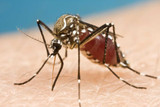Light pollution may increase biting behavior at night in Aedes aegypti mosquitoes
Artificial light abnormally increases mosquito biting behavior at night in a species that typically prefers to bite people during the day, according to research from the University of Notre Dame that was published in The American Journal of Tropical Medicine and Hygiene.
Increased biting by Aedes aegypti mosquitoes, which normally fly and bite in the early morning and during the afternoon, highlights the concern that increasing levels of light pollution could impact transmission of diseases such as dengue fever, yellow fever, chikungunya and Zika.
"This is potentially a very valid problem that shouldn't be overlooked," said Giles Duffield, associate professor in the Department of Biological Sciences, who is also affiliated with the Eck Institute for Global Health and the Neuroscience and Behavior Program. Unlike other species that may emerge from the forest to feed on humans and animals, Aedes aegypti evolved with humans and prefers to feed on them.
"They live and breed in the vicinity of houses, so the chances of Aedes aegypti being exposed to light pollution are very likely," he added.
To conduct the experiment, the study's first author, Samuel S. C. Rund, a staff scientist in the Department of Biological Sciences, allowed mosquitoes in cages to bite his arms under controlled conditions, including during the day, at night or at night while exposed to artificial light. The female mosquitoes -- the only ones that bite -- were twice as likely to bite, or blood-feed, at night when they were exposed to artificial light. Twenty-nine percent of the mosquitoes in the control group, which had no light, fed at night, while 59 percent of the mosquitoes exposed to artificial light blood-fed.
The findings will help epidemiologists better understand the true risk of disease transmission by this species. The discovery could also lead to more recommendations for bed net use. Usually mosquito bed nets are used at night to ward off bites from a different genus of mosquitoes, Anopheles, but because Aedes aegypti were shown to be stimulated by artificial light, mosquito nets could also be used in areas with a likelihood of disease transmission even with limited Anopheles activity.
"The impact of this research could be huge, and it probably has been overlooked," Duffield said. "Epidemiologists may want to take light pollution into account when predicting infection rates."
Duffield and his collaborators plan to experiment with additional variables of artificial light to further study Aedes aegypti biting activity. These variables include the duration of light, its intensity and color, and the timing of the biting -- whether early at night or later. The team is also interested in the molecular genetic pathways that might be involved with biting activity, after noticing that not every mosquito in the population under study was interested in biting at night even with artificial light.
"So, we think there is a genetic component within the Aedes aegypti species," Duffield said.
Journal Reference:
- Samuel S. C. Rund, Laura F. Labb, Owen M. Benefiel, Giles E. Duffield. Artificial Light at Night Increases Aedes aegypti Mosquito Biting Behavior with Implications for Arboviral Disease Transmission. The American Journal of Tropical Medicine and Hygiene, 2020; DOI: 10.4269/ajtmh.20-0885
Recent Posts
-
Dengue fever deaths surge in Caribbean and Americas due to climate crisis
Warmer weather brought on by climate crisis enables mosquitoes that carry virus to expand their reac …12th Dec 2024 -
5 Benefits of Using Bed Canopy Mosquito Nets for Your Bedroom | MosquitoNets.com
5 Benefits of Using Bed Canopy Mosquito Nets for Your BedroomLooking for a simple yet elegant solut …20th Nov 2024 -
Novel way to beat dengue: Deaf mosquitoes stop having sex
Scientists believe they have found a quirky way to fight mosquito-spread diseases such as dengue, ye …7th Nov 2024




